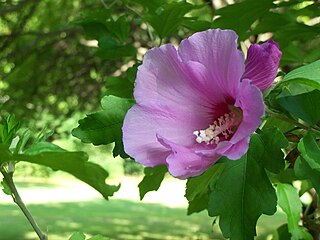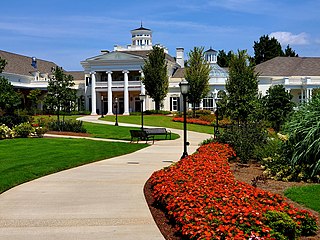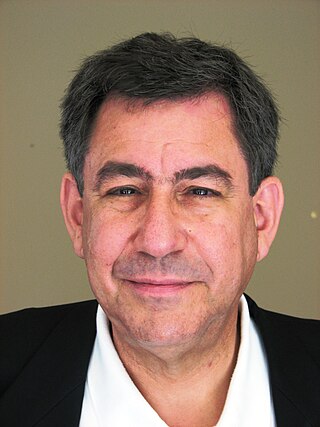
The Missouri Botanical Garden is a botanical garden located at 4344 Shaw Boulevard in St. Louis, Missouri. It is also known informally as Shaw's Garden for founder and philanthropist Henry Shaw. Its herbarium, with more than 6.6 million specimens, is the second largest in North America, behind that of the New York Botanical Garden. The Index Herbariorum code assigned to the herbarium is MO and it is used when citing housed specimens.

Rose of Sharon is a biblical expression, though the identity of the plant referred to is unclear and is disputed among biblical scholars. It has become a common name for several different species of flowering plants that are valued in different parts of the world. In neither case does it refer to actual roses. The name's varied colloquial application has been used as an example of the lack of precision of common names, which can potentially cause confusion. "Rose of Sharon" has become a frequently used catch phrase in poetry and lyrics.
Biblical hermeneutics is the study of the principles of interpretation concerning the books of the Bible. It is part of the broader field of hermeneutics, which involves the study of principles of interpretation, both theory and methodology, for all forms of communication, nonverbal and verbal.
Reginald Cuthbert Fuller was a Catholic priest, biblical scholar and honorary Canon of Westminster Cathedral. He celebrated his 100th birthday in 2008.

The Huntsville Botanical Garden is a 118 acres (480,000 m2) botanical garden located at 4747 Bob Wallace Avenue, Huntsville, Alabama, near the U.S. Space & Rocket Center. It is open year-round for a fee. The garden is ranked third on the list of Alabama's top paid tourist attractions, receiving 353,841 visitors in 2018.

The Rodef Shalom Biblical Botanical Garden in Pittsburgh, Pennsylvania's Shadyside section is a Biblical botanical garden.

Rodef Shalom Congregation is an historic Reform Jewish congregation and synagogue located at 4905 Fifth Avenue, Pittsburgh, Pennsylvania, in the United States. The landmark building was designed by architect Henry Hornbostel and completed in the Beaux-Arts style.

The Diocese of Moray, Ross and Caithness is one of the seven dioceses of the Scottish Episcopal Church. It covers Caithness and Sutherland, mainland Ross and Cromarty, and mainland Inverness-shire, Nairnshire, Moray and Banffshire. The diocesan centre is St Andrew's Cathedral in Inverness. The see is currently occupied by Mark Strange.

Ulmus castaneifoliaHemsley, the chestnut-leafed elm or multinerved elm, is a small deciduous tree found across much of China in broadleaved forests at elevations of 500–1,600 metres (1,600–5,200 ft).

Ulmus macrocarpaHance, the large-fruited elm, is a deciduous tree or large shrub endemic to the Far East excluding Japan. It is notable for its tolerance of drought and extreme cold and is the predominant vegetation on the dunes of the Khorchin sandy lands in the Jilin province of north-eastern China, making a small tree at the base of the dunes, and a shrub at the top.

Ulmus lamellosa, commonly called the Hebei elm, is a small deciduous tree native to four Chinese provinces, Hebei, Henan, Nei Mongol, and Shanxi, to the west and south of Beijing.
Ulmus bergmanniana var. lasiophyllaC. K. Schneid. is endemic to China, on mountain slopes at elevations of 2100–2900 m in Gansu, Shaanxi, north-west Sichuan, south-east Xizang, and north-west Yunnan.

Anemone hepatica, the common hepatica, liverwort, liverleaf, kidneywort, or pennywort, is a species of flowering plant in the buttercup family Ranunculaceae, native to woodland in temperate regions of the Northern Hemisphere. This herbaceous perennial grows from a rhizome.

Benedict Thomas Viviano a New Testament scholar and author, was a member of the Chicago Province of the Dominican Order of the Roman Catholic Church. He was on the faculty of the University of Fribourg, Switzerland, as a full professor of New Testament, teaching in the French language. Before teaching in Fribourg, he taught for 11 years at the Ecole Biblique in Jerusalem, and 12 years at Aquinas Institute of Theology in St. Louis. He was vice president of the Tantur Ecumenical Institute for Theological Studies in Jerusalem.
The Seinan Gakuin University Biblical Botanical Garden is a Biblical garden, one of a number botanical gardens located across the campus of Seinan Gakuin University, Nishijin 6-2-92, Sawara-ku, Fukuoka, Fukuoka, Japan. It is open daily.
Walter Jacob is an American Reform rabbi who was born in Augsburg, Germany, and immigrated to the United States in 1940.

Ulmus parvifolia, commonly known as the Chinese elm or lacebark elm, is a species native to eastern Asia, including China, India, Japan, Korea, and Vietnam. It has been described as "one of the most splendid elms, having the poise of a graceful Nothofagus".
William Frederick Beck was an American Lutheran minister best known for his biblical translation, The Holy Bible, An American Translation.












